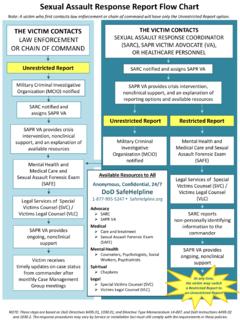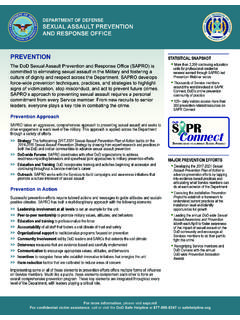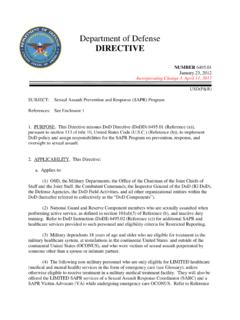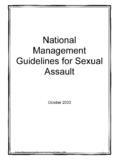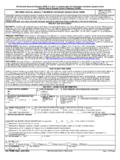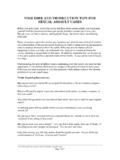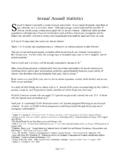Transcription of Forensic Exams for the Sexual Assault Suspect - mysati.com
1 June 28, 2007 Forensic Exams for the Sexual Assault Suspect By Joanne Archambault, SATI Training Director and Founder of EVAW International One source of evidence that is critically important but all too often overlooked in a Sexual Assault investigation is the Suspect examination. In my experience, I have found that most law enforcement agencies have failed to establish appropriate policies and procedures for obtaining comprehensive Forensic examinations for Sexual Assault suspects which is unfortunate, given the potential for recovering probative evidence from the body as well as the clothing of suspects . The purpose of this Promising Practices article is to make the case for the importance of Suspect examinations, to explore some of the reasons why they often are not done, and to provide concrete recommendations for overcoming these barriers and using Suspect examinations effectively in your community.
2 The importance of Suspect Exams . When evaluating potential sources of evidence, we as law enforcement professionals often focus on anything that might have transferred from the Suspect to the victim; thus, Forensic examinations of the victim are seen as critically important. However, we need to keep in mind that any evidence that could potentially be transferred from the Suspect to the victim may also be transferred from the victim to the Suspect . Therefore, depending on the type of contact involved in a Sexual Assault offense, the Suspect s body may actually be a better source of probative evidence than the victim s. For example, in the case of a digital penetration of the victim s vagina, the Suspect s fingers will often be the best source of probative evidence. This can even be true if the Suspect has bathed since the Sexual Assault , because most people do not routinely scrub underneath their fingernails with hot soapy water.
3 As another example, if the Suspect forced his penis into the victim s mouth during the Sexual Assault , his penis may be a richer source of evidence than the victim s mouth. To highlight this point, consider a study conducted by Isacc T. Caain, entitled: The Use of Physical Evidence in the Investigation and Prosecution of Sexual Assault Cases. (This study was submitted as a Master s Thesis in Forensic Sciences to National University in July of 2002). The research was conducted while I was supervising the Sex Crimes Unit at the San Diego Police Department, and it involved analyzing the findings from 77 Sexual Assault cases that received laboratory analysis from our Forensic Biology Unit between 1998 and 1999. Results of this study revealed the following: In cases involving an adolescent victim, 44% of the Suspect s rape kits that were examined by a criminalist identified the victim s DNA.
4 In fact, DNA analysis of epithelial cells found on penile swabs of the known Suspect were the most common pieces of Suspect evidence associated with victim identification. In the cases with an adult victim, as many as 30% of the Suspect s rape kits that were examined by a criminalist identified the victim s DNA. Again, DNA analysis of epithelial cells found on penile swabs of the known Suspect were the most common pieces of Suspect evidence associated with victim identification. Clearly, any evidence from the Suspect s body that establishes the identity of the victim will be important in the investigation and prosecution of Sexual Assault . It is therefore surprising that so few law enforcement agencies routinely collect Forensic evidence from the body of the Suspect . The clothing of the Suspect Equally surprising is the frequent failure to seize the Suspect s clothing, which again could be a terrific source of probative evidence.
5 In many cases, the clothing worn by the Suspect during the Sexual Assault is still available and depending on the specific case history and the time since the Assault it is often a better source of evidence than the Forensic examination of the victim. All of these potential sources of evidence should therefore be considered when thinking outside the box during a Sexual Assault investigation. Turning again to the Caain study: When the Suspect s clothing and other crime scene evidence such as condoms, bottles and tissue, were examined, 80% of the items examined by a criminalist included the victim s DNA profile and 20% included the Suspect s DNA profile. Of the 51 adult cases, of the items examined by a criminalist included the Suspect s DNA profile and 50% included the victim s DNA profile. Clearly, important evidence can often be obtained from the body and clothing of a Suspect in a Sexual Assault case.
6 This is especially significant because so many people think of Sexual Assault cases as not having physical evidence that they are simply a question of he said, she said. In many cases, however, physical evidence can be obtained if we look in the right place. It s not just about DNA identification Yet the importance of the Suspect examination is not solely based on the potential for documenting the victim s DNA for identification purposes. Depending on where the victim s DNA is found on the Suspect s body, it may provide a better idea of the specific acts that were involved in the Sexual Assault ( , penile-vaginal penetration, digital penetration, oral copulation). This type of evidence may be particularly helpful with very young victims, or with victims who are under the influence of drugs or alcohol, because they may not recall or may not be able to articulate exactly what happened to them.
7 Evidence of the victim s DNA on the Suspect s body can also be important in cases involving multiple perpetrators, where the victim knows that a Suspect participated in the Assault but is not sure if he penetrated her. Even beyond DNA evidence, the Suspect examination is important because it can provide documentation of the Suspect s clothing, appearance ( , shaven or unshaven), physical anomalies, tattoos, piercings, and other characteristics that may become important later on during the course of an investigation and prosecution (thanks to Assistant District Attorney Cathy Stephenson in San Diego, California for these ideas). It can also corroborate information that the victim provides about sensory experiences, such as the Suspect s smell ( , aftershave, cigarettes, body odor, bad breath). Evidence from the Suspect examination can also provide other types of information that fill in pieces of what happened before, during, or after the Sexual Assault .
8 For example, debris from leaves could be found on the Suspect s body that came from the bushes outside the victim s home, or paint chips could remain from the Suspect s work earlier in the day. A thorough Suspect examination certainly demonstrates diligence on the part of law enforcement investigators and establishes a critical focus on the Suspect both of which are important for juries considering the evidence in the case (thanks to Senior Deputy Prosecuting Attorney Patti Powers in Yakima, Washington for these ideas). Yet one of the most important reasons for conducting a Suspect examination is to document evidence of force, resistance, and injury. As you know, most Sexual Assault cases result in a consent defense these days even when the Suspect is a stranger to the victim. Therefore, biological and trace evidence may not be as critical for establishing the identity of the Suspect as one might initially think.
9 Yet many investigators assume that this means a Suspect examination will not be particularly useful, and that is not necessarily true. A Suspect examination may still be extremely useful in a consent defense case, because the evidence that is obtained may corroborate the victim s (and/or Suspect s) account of events. The evidence may also document force or injury, which is obviously critical for overcoming a consent defense. In fact, any time a victim describes a great deal of force involved in their Sexual Assault or when victims state that they bit, kicked, or scratched the Suspect injuries to the Suspect might still be identified and documented for days afterward. Clearly, the decision to obtain a Suspect examination should not be based solely on an understanding of how long trace and biological evidence might be available on the Suspect s body.
10 In the majority of Sexual Assault cases where consent is going to be the primary issue, any evidence that provides corroboration of the victim s account and documents force or injury is absolutely critical. As a result, the determination of whether or not to obtain a Suspect examination can only come from a careful consideration of the case history. Investigators must think through the facts of the case and determine what kinds of evidence might prove useful and for what purposes. At a minimum, I can recommend that a Forensic examination of the Suspect should be conducted any time (1) the Suspect is arrested shortly after the Sexual Assault , (2) the law enforcement investigator believes that the Suspect has not bathed since the Sexual Assault (however, keep in mind that depending on the type of Assault , an exam may still be warranted even if the Suspect has bathed), or (3) if there is reason to believe there might still be evidence of injury to the Suspect .
